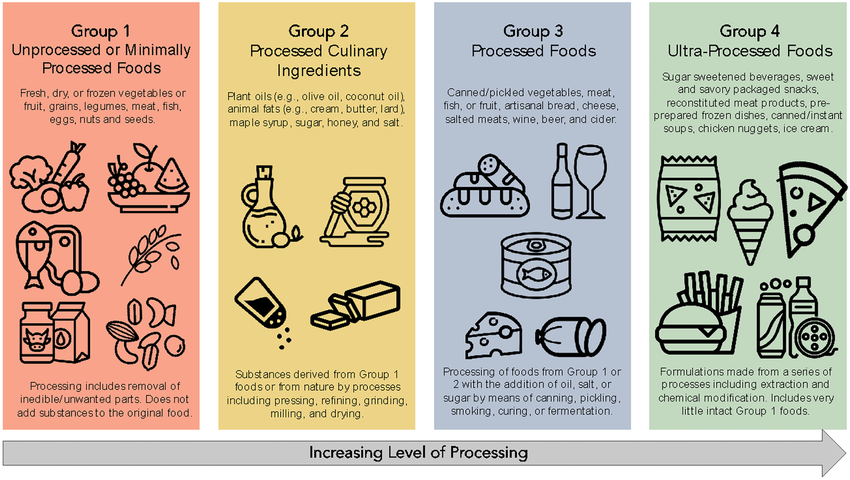The NOVA Food Classification System
Published on 13th October 2024 by Phil Elson
NOVA is a simple Food Classification system based on the extent and purpose of food processing. We've seen personally and from our research that processed foods are a driving force in the rise of non-communicable diseases, such as Obesity, Type 2 Diabetes and Cardio Vascular Disease.
The below information has been extracted from the "World Nutrition Volume 7, Number 1-3, January-March 2016 - Food classification. Public health NOVA. The star shines bright"
- Group 1
- Unprocessed (whole) or minimally processed foods
- Vegtables, Fruits, Legumes, Tubes, Coffee, Tea etc
- Make unprocessed or minimally processed foods the basis of your diet
- Group 2
- Processed culinary ingredients
- Group 2 items are rarely consumed in the absence of group 1 foods. Sea Salt, Honey, Seed + Vegtable Oils, Butters
- Use processed culinary ingredients in small amounts for seasoning and cooking foods and to create culinary preparations
- Group 3
- Processed foods
- Canned or bottled vegetables, fruits and legumes, salted or sugared nuts and seeds; salted foods, fruits, unpackaged freshly made breads, Beer, Cider, Wine
- Limit the use of processed foods, consuming them in small amounts as components of culinary preparations or as part of meals based on natural or minimally processed foods
- Group 4
- Ultra-processed food and drink products
- These are industrial formulations typically with five or more and usually many ingredients such as sugar, oils, fats, salt, anti-oxidants, stabilisers, and preservatives. Substances only found in ultra-processed products include some directly extracted from foods, such as casein, lactose, whey, and gluten, and some derived from further processing of food constituents, such as hydrogenated or interesterified oils, hydrolysed proteins, soy protein isolate, maltodextrin, invert sugar and high fructose corn syrup. Classes of additive only found in ultra-processed products include dyes and other colours, colour stabilisers, flavours, flavour enhancers, non-sugar sweeteners, and processing aids such as carbonating, firming, bulking and anti-bulking, de-foaming, anti-caking and glazing agents, emulsifiers, sequestrants and humectants.
- Warning AvoidBecause of their ingredients, ultra-processed products – such as packaged snacks, soft drinks, and instant noodles – are nutritionally unbalanced. As a result of their formulation and presentation, they tend to be consumed in excess, and displace natural or minimally processed foods. Their means of production, distribution, marketing, and consumption damage culture, social life, and the environment.

For more information
- Metabolical: The truth about processed food and how it poisons people and the planet
- Monteiro, C. A., Cannon, G., Moubarac, J.-C., et al. (2018). The UN Decade of Nutrition, the NOVA food classification and the trouble with ultra-processing. Public Health Nutrition, 21(1), 5-17.
- NOVA Food Classification System. (n.d.). Retrieved from the Food and Agriculture organisation of the United Nations website.
- Openfoodfacts.org Nova
- World Nutrition Volume 7, Number 1-3, January-March 2016 - Food classification. Public health NOVA. The star shines bright

